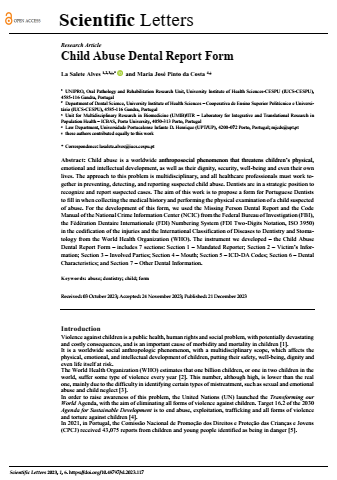Child Abuse Dental Report Form
DOI:
https://doi.org/10.48797/sl.2023.117Keywords:
abuse, dentistry, child, formAbstract
Child abuse is a worldwide anthroposocial phenomenon that threatens children’s physical, emotional and intellectual development, as well as their dignity, security, well-being and even their own lives. The approach to this problem is multidisciplinary, and all healthcare professionals must work together in preventing, detecting, and reporting suspected child abuse. Dentists are in a strategic position to recognize and report suspected cases. The aim of this work is to propose a form for Portuguese Dentists to fill in when collecting the medical history and performing the physical examination of a child suspected of abuse. For the development of this form, we used the Missing Person Dental Report and the Code Manual of the National Crime Information Center (NCIC) from the Federal Bureau of Investigation (FBI), the Fédération Dentaire Internationale (FDI) Numbering System (FDI Two-Digits Notation, ISO 3950) in the codification of the injuries and the International Classification of Diseases to Dentistry and Stomatology from the World Health Organization (WHO). The instrument we developed – the Child Abuse Dental Report Form – includes 7 sections: Section 1 – Mandated Reporter; Section 2 – Victim’s Information; Section 3 – Involved Parties; Section 4 – Mouth; Section 5 – ICD-DA Codes; Section 6 – Dental Characteristics; and Section 7 – Other Dental Information.
References
Hoehn, E.F.; Wilson, P.M.; Riney, L.C.; Ngo, V.; Bennett, B.; Duma, E. Identification and Evaluation of Physical Abuse in Children. Pediatr Ann 2018, 47, e97-e101, doi:10.3928/19382359-20180227-01.
World Health Organization. Global Status Report on Preventing Violence Against Children 2020; Geneva, 2020.
World Health Organization. World report on violence and health; Geneva, 2002.
United Nations. Transforming Our World: The 2030 Agenda for Sustainable Development - Seventieth Session; New York, 2015.
Comissão Nacional de Promoção dos Direitos e Proteção das Crianças e Jovens. Relatório Anual de Avaliação da Atividade das CPCJ 2021; CNPDPCJ: Lisbon, 2022; p 28.
Comissão Nacional de Promoção dos Direitos e Proteção das Crianças e Jovens. Comissão Nacional de Promoção dos Direitos e Proteção das Crianças e Jovens. Availabe online: https://www.cnpdpcj.gov.pt/cpcj (accessed on 24 November 2023).
World Health Organization. Violence against children. Availabe online: https://www.who.int/health-topics/violence-against-children#tab=tab_1 (accessed on 24 November 2023).
Crespo, M.; Andrade, D.; Alves, A.L.; Magalhaes, T. [The dentist's role in the child abuse: diagnosis and report]. Acta Med Port 2011, 24 Suppl 4, 939-948.
Magalhães, T.; Jardim, P.; Santos, L. Indicadores físicos de abuso. In Abuso de Crianças e Jovens: Da suspeita ao diagnóstico, Magalhães, T., Ed. LIDEL - Edições Técnicas, Lda.: Lisbon, 2010; pp. 51-108.
American Academy of Pediatrics Committee on Child, A.; Neglect; American Academy of Pediatric, D.; American Academy of Pediatric Dentistry Council on Clinical, A. Guideline on oral and dental aspects of child abuse and neglect. Pediatr Dent 2008, 30, 86-89.
Welbury, R.R.; Murphy, J.M. The dental practitioner's role in protecting children from abuse. 3. Reporting and subsequent management of abuse. Br Dent J 1998, 184, 115-119, doi:10.1038/sj.bdj.4809557.
Federal Bureau of Investigation - National Crime Information Center (NCIC). Missing Person Dental report; 2005; pp 26-35.
Federal Bureau of Investigation - Criminal Justice Information Services (CJIS) Division. Code Manual of the National Crime Information Center (NCIC). LEO Program Office; 2000.
FDI World Dental Federation. FDI Two-Digit Notation. Availabe online: http://www.fdiworldental.org/ (accessed on 24 November 2023).
International Organization for Standardization (ISO). Dentistry - Designation system for teeth and areas of the oral cavity. In ISO 3950:2009, ISO, Ed. 2009.
World Health Organization. Application of the International Classification of Diseases to Dentistry and Stomatology (ICD-DA); Geneva, 1995.
Hillis, S.; Mercy, J.; Amobi, A.; Kress, H. Global Prevalence of Past-year Violence Against Children: A Systematic Review and Minimum Estimates. Pediatrics 2016, 137, e20154079, doi:10.1542/peds.2015-4079.
Machado, C.; Goncalves, M.; Matos, M.; Dias, A.R. Child and partner abuse: self-reported prevalence and attitudes in the north of Portugal. Child Abuse Negl 2007, 31, 657-670, doi:10.1016/j.chiabu.2006.11.002.
Nunes, P.; Raminhos, I. [Child abuse - a district hospital's reality!]. Acta Med Port 2010, 23, 413-418.
Vidal, H.G.; Caldas, I.M.; Coelho Junior, L.; Souza, E.H.A.; Carvalho, M.V.D.; Soriano, E.P.; Pereira, M.L.; Caldas, A.F., Jr. Orofacial Injuries in Children and Adolescents (2009-2013): A 5-Year Study In Porto, Portugal. Braz Dent J 2018, 29, 316-320, doi:10.1590/0103-6440201801830.
American Board of Forensic Odontology (ABFO). Body Identification Information & Guidelines; 2017.

Downloads
Published
How to Cite
Issue
Section
License
Copyright (c) 2023 La Salete Alves, Maria José Pinto da Costa

This work is licensed under a Creative Commons Attribution 4.0 International License.
In Scientific Letters, articles are published under a CC-BY license (Creative Commons Attribution 4.0 International License), the most open license available. The users can share (copy and redistribute the material in any medium or format) and adapt (remix, transform, and build upon the material for any purpose, even commercially), as long as they give appropriate credit, provide a link to the license, and indicate if changes were made (read the full text of the license terms and conditions of use).
The author is the owner of the copyright.








